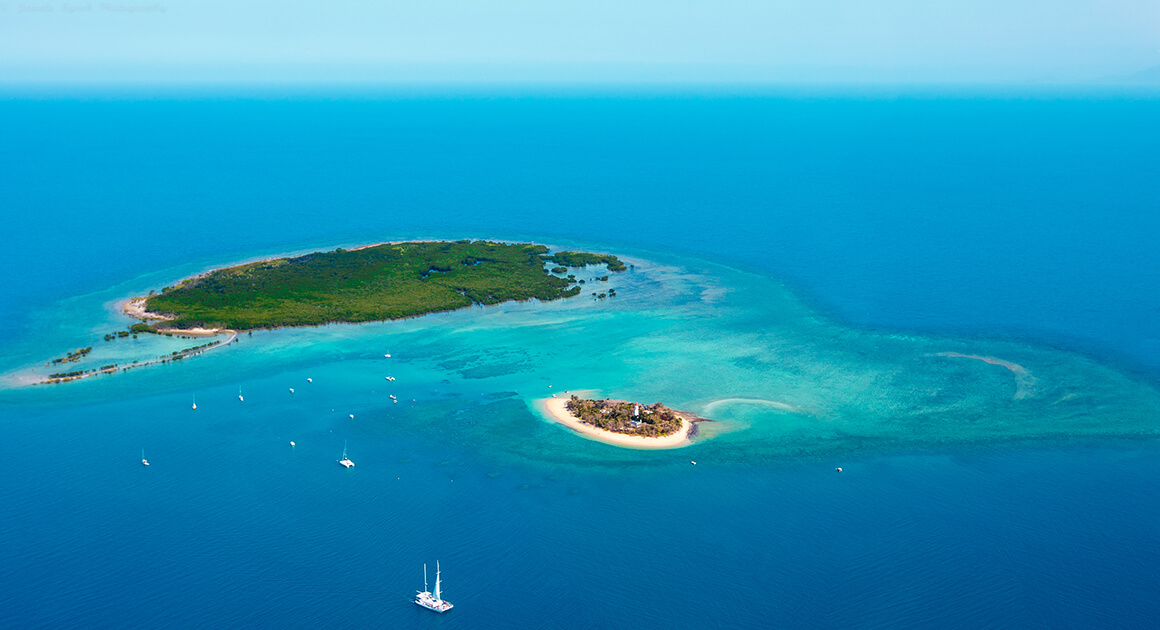
Low Isles
On one of our crystal clear days you can see Low Isles shimmering on the horizon of the Coral Sea like a mirage. Situated just off the coast of Port Douglas, Low Isles is made up of two small coral cay islands surrounded by 55 acres of reef. The two small islands are separate but share the common reef. Aboriginal people know these islands as Wungkun, and is an important indigenous cultural site for both the local KuKu Yalanji and Yirraganydji tribes.
The smaller of the Low Isles is a coral cay with a lighthouse that has been operating since 1878. Located within the Marine National Park Zone of the Great Barrier Reef Marine Park, Low Isles and its historic lighthouse were registered on the Commonwealth Heritage List in June 2008 in recognition of their place in Australia’s cultural and Indigenous heritage. They also fall under the protection of the Great Barrier Reef Marine Park Authority.
The larger of the two islands - Woody Island - is uninhabited unless you count the sizeable bird population, and is also a vital habitat for many other bird species and marine wildlife. Part of the caretaker’s role on the island is to monitor these populations, reporting back to the Great Barrier Reef Marine Park Authority (GBRMPA).
There are 150 different species of hard corals in the waters surrounding Low Isles, although these are dominated by 15 species of soft corals. Living amongst the corals is a large variety of fish, molluscs, sea cucumbers and other animals. Colourful blue, green and purple parrotfish are a common sight as well as angelfish, damselfish, clownfish, trevally, sweetlip, and moon wrasse, just to name a few. As well, the island has a prolific turtle population with underwater sightings common to snorkellers.
Weather data has also been gathered from the island since 1887, and still today remains the region’s primary point of weather forecasting through the Bureau of Meteorology.
Low Isles Highlights
SNORKELLING
Low Isles is a fantastic place to tackle snorkelling for the first time. To gain your confidence, from the beach in the shallows, or for the more proficient by making good use of a pair of fins at a leisurely pace or for the more adventurous you can jump off the bow off a visiting vessel.
Don’t like swimming? Try a glass bottom boat tour, a stand up paddle-board or take to the air in a helicopter to appreciate a birds eye view.
GIANT CLAMS
With an average lifespan of 100 years in the wild, this impressive bivalve mollusc, more commonly referred to as a Giant Clam are sight to behold. At times weighing more than 200kg, showcasing its translucent colours it feeds on passing plankton, which it syphons from the water it draws through its large opening. Awesome!
BEACH WALK
Although easily navigated in 15 minutes, slow down, enjoy the moment and take time to relax and enjoy the flora and fauna, beach comb as you stroll (leaving for others to enjoy please) and read about the history of the island.
SEA TURTLES
You simply never tire of seeing these magnificent creatures in their natural habitat. As they feed on marine plants such as seaweed, sea grass and algae they are graceful, inquisitive and majestic to behold.
REEF SHARKS
If swimming with sharks is on your bucket list – this is the ideal place to do it!
One of the smaller species, not typically aggressive and generally quite shy look out for the aptly named dorsal fins of the “white” tipped Reef Sharks as they explore Lowe Isles along side you.
OSPREY
Whilst there is an array of birdlife to be seen on Lowe Isles such as Terns, Egrets and Imperial pigeons you cannot help but notice the huge nest(s) that seem to regularly frequent the roof of the resident Lighthouse. Often the home of a fish eating raptor commonly know as an Osprey and whilst impressive in flight these inhabitants seem quite content to perch on the roof, with a watchful eye as if they rule over the island
BAT FISH
These beautifully stripped fish are omnivores and feed on small invertebrates as well as seaweed. Quite often seen in groups at this location in the blue water, these fish are quietly confident and seem to enjoy coming to say hello.
Conservation on Low Isles
Care for Low Isles is managed by the Low Isles Protection Society (LIPS) and the Great Barrier Reef Marine Park Authority with permanent live in care takers managing the island day to day.
Low Isles is the first island in the Great Barrier Reef Marine Park where the island operations are carbon neutral - the island operations are sustained completely by solar power. With an Energy Management Plan to ensure the carbon neutral status is maintained, the caretakers provide a working example of sustainability in a remote setting, ideally encouraging regular land-dwellers to recognise the many ways to combat climate change
Getting There
Take a scenic catamaran ride out to Low Isles or if you have a need for speed why not book a tour with Reef Sprinter the exciting speed boat ride can get you to Low Isles in just 15 minutes!
Book your half day Low Isles tour today



